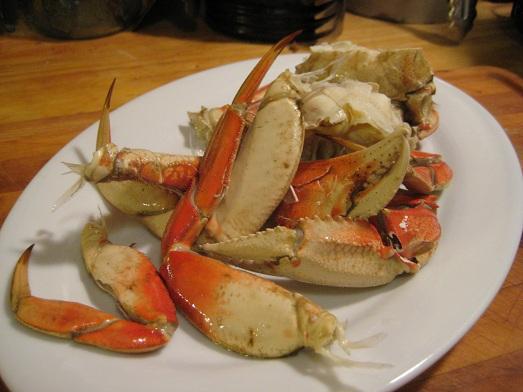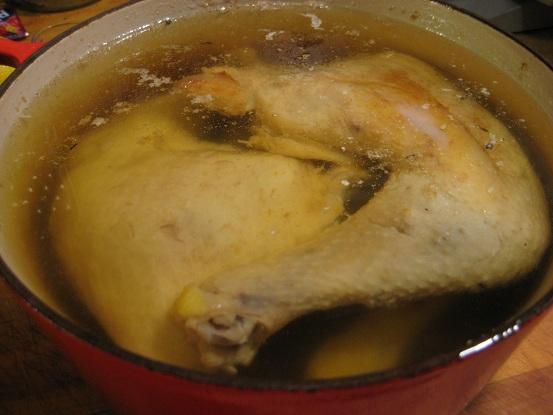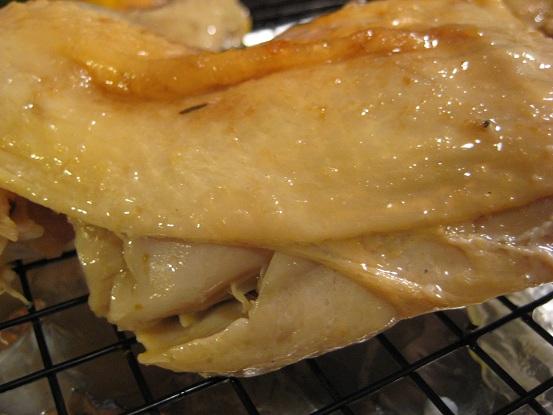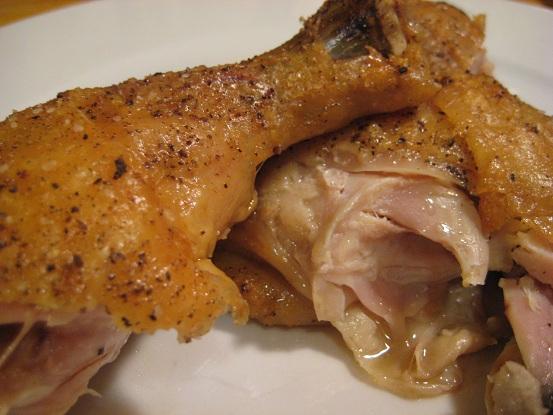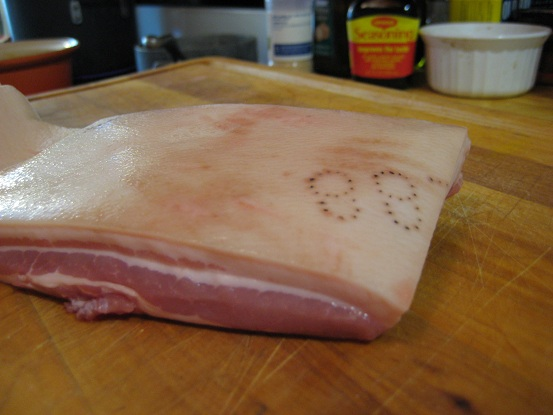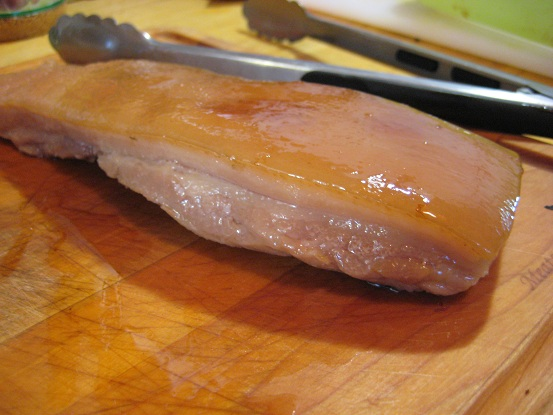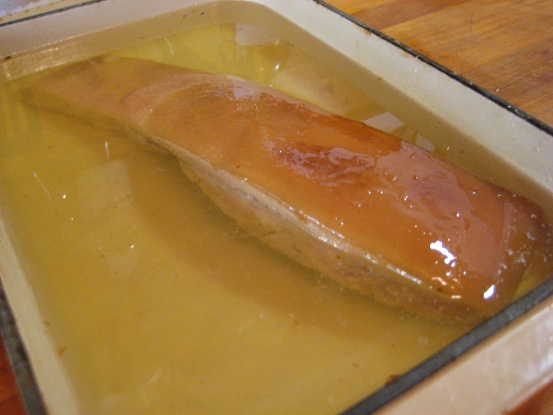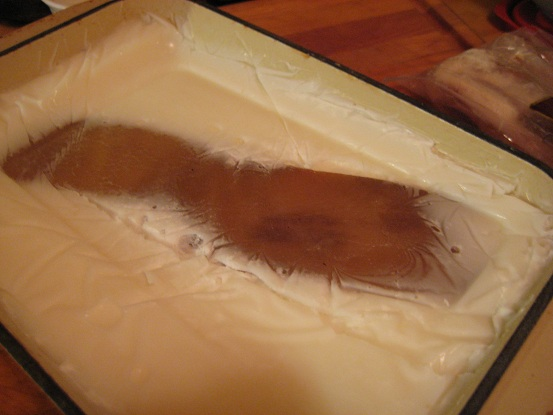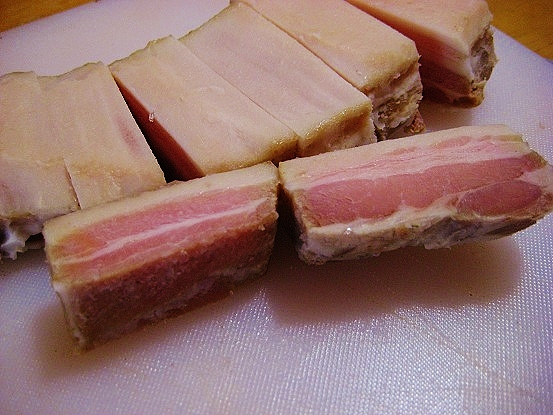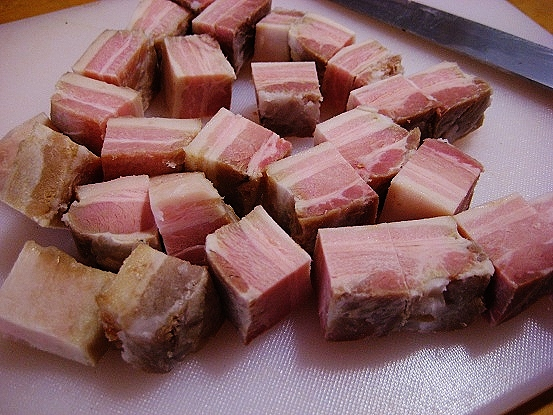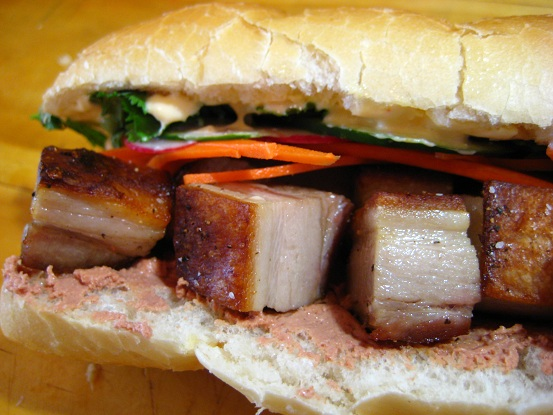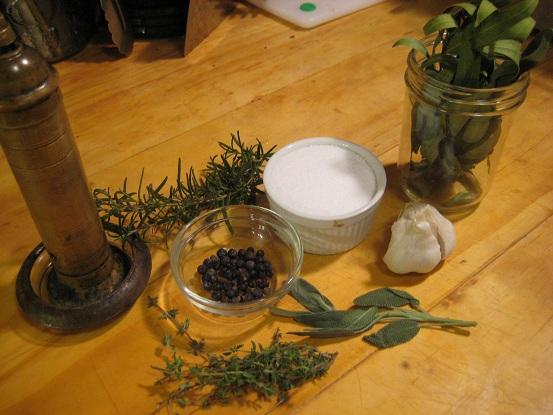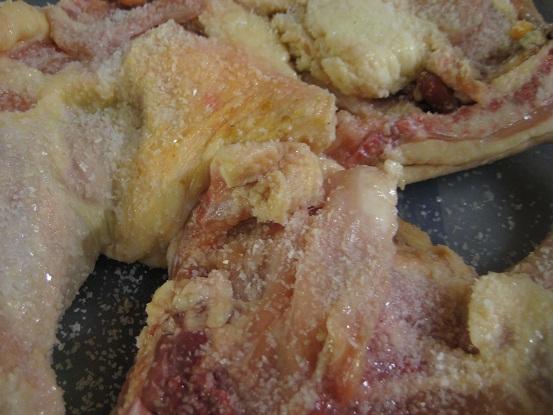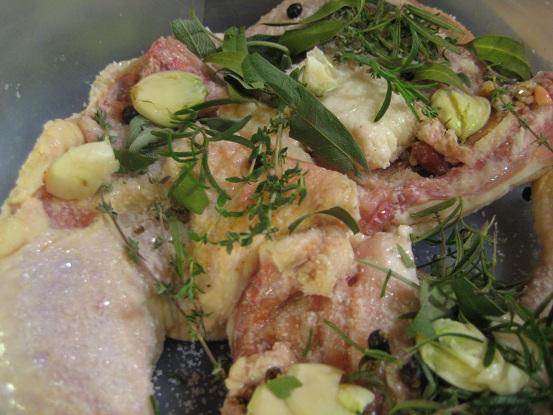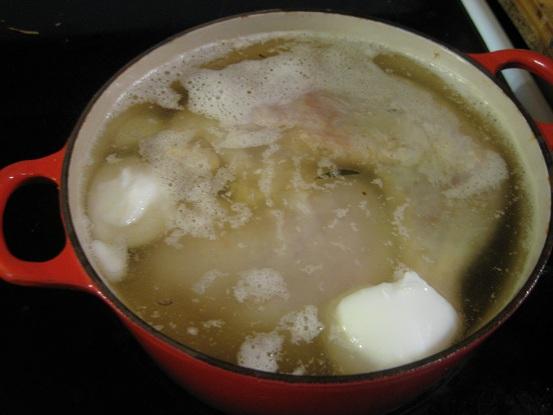-
Posts
5,035 -
Joined
-
Last visited
Content Type
Profiles
Forums
Store
Help Articles
Everything posted by David Ross
-
You make a great point--chicken is a wonderful ingredient for learning and experimenting with confit. It's cheap, readily available and can stand up to the traditional or sous-vide methods. Best of all, the results are incredible. It's really quite amazing how this process can make a humble chicken so delicious. I've got my whole quail cooked and now encased in fat so I'll let it sit this week and then prepare it next weekend. I've got a first course in mind for the quail and a warm salad.
-
Just prepped some whole quail for confit. They won't yield much meat, but it's more of an experiment rather than a quail confit feast. I'm either going to roast them whole or shred the meat and put it in spring rolls, maybe with a Korean bbq sauce.
-
Sometimes you can go to an Asian store and get great deal, 1/2 price, on crippled crabs and lobsters. They are just as fresh, but with one claw or a couple of legs missing. dcarch Nothing beats the freshness of Dungeness crab.
-
$12.00 per pound. Some supermarkets in the Northwest sell crab this time of year for as low as $3.99 per pound, but sometimes it's crab that's a few weeks old. My fishmonger only sells deep-water crabs that have a harder shell and larger body and he gets them in fresh daily within a day of harvest. Last year's commercial season was terrible, but we think this season is looking pretty good.
-
A treat the first week of December every year (depending on conditions and limits), fresh Dungeness Crab. Steamed, chilled, cracked served with melted butter and fresh lemon.
-
I would think the layer of fat will protect the confit, but probably only if the jars are refrigerated. At room temp the liquid in the bottom could spoil. In any case, I refrigerate my confit and it stays safe for weeks.
-
Why not confit the turkey from the get-go (yeh, kind of late for that now, but there's next year, and a test run could be made on the unsold turkeys that inevitably go on sale immediately after Thanksgiving)? Plenty of people are looking for a different slant on the Thanksgiving day centerpiece, but can't bring themselves to give up actual turkey. I just got home from the Thanksgiving Holiday with family. They have been loosely following this Cook-Off, and while the photos have tempted them, they think Confit is difficult to make. (Mind you, these are not studious cooks). I said it isn't difficult, it just takes time. I'm confident I got them to agree that turkey confit would be delicious. I'm starting a batch this coming week.
-
Confit just never seems to fail. That is beautifully moist chicken.
-
Another thought came to mind yesterday--this week all manner of turkeys are on sale, organic, free-range, butterball, fresh or frozen. It's probably the best time of the year to buy turkey for confit. But I wonder, could you make Confit from leftover turkey? Or, since the turkey is already cooked are you basically defeating the purpose of the Confit process?
-
Yes, it was a very delicate task to gently remove the chicken quarters from the fat with the skin tearing, let alone the bones slip out. And I've found chicken skin to be much thinner than the skin of a duck. Tonight I'm going to do a pasta dish using the chicken confit but without the skin so I won't have to worry about the darn thing falling apart.
-
Thanks. You'll find the recipe in Keller's "ad hoc at home."
-
Thank you. I am going to chill some of it in the fridge and take it to work for lunch tommorrow. I can only imagine what the other employees will think. Chicken? Confit?
-
Tonight I served some of the first batch of Chicken Confit that I started curing about two weeks ago. The final preparation of the dish started with melting the fat over a low heat on the stovetop- Then gently, very gently, the chicken quarters are removed from the fat and placed on a rack over a cookie sheet to heat in a searing-hot 550 oven for about 15 minutes- A closeup of what this silky, lush, bird looks like after being suspended in pork lard for two weeks, (and it gets better)- After heating through and crisping the skin until it crackles, the chicken confit is finished. Served with a salad of spinach and red chard dressed with mustard, hazelnut oil, apple cider vinegar, lemon juice and olive oil with a garnish of toasted pecans. I chose to go simple tonight with a salad dressed with tangy, citrus and fruit notes to counter the rich, salty profile of the confit with a bit of sweet crunch added with the pecans-
-
Those are interesting flavors. Tell us about the banana and how the sweetness worked with the duck.
-
That is one amazing dish. I'm intrigued by the use of the five-spice and I may use that in a duck confit I plan to do and make into spring rolls.
-
When I started our Confit journey, I totally forgot that during our Banh Mi Cook-Off last summer, (http://forums.egullet.org/topic/143083-cook-off-60-banh-mi/page-3), I had combined the French technique of Confit with the Vietnamese elements of this delicious sandwich. Thanks to a recipe from Thomas Keller, this is absolutely my favorite way to prepare pork. The result is incredibly tender, juicy meat with a crackling, caramelized crust. I buy fresh pork belly at the local Asian market, but I'm particular in choosing the thickest, meatiest slab I can find, (otherwise you're just buying pork belly fat). Like the chicken confit that is currently in my refrigerator, the Pork Belly Confit takes time, starting with brining a nice fat pork belly overnight. The brine is a mixture of honey, bay leaves, rosemary, thyme, parsley, garlic and black peppercorns. I find all of Keller's brine recipes too salty for my tastes, (he uses a ratio of 8 cups water to 1 cup Kosher salt), so I cut the salt in half for the amount of water. Sometimes I add juniper berries or lavendar to the brine- One important part of this recipe is to leave the "rind" or outer layer of skin on the pork belly until the final stages of cooking. In some dishes I'll cut the skin off, akin to removing the skin off a salmon. The pork belly is put in the LeCreuset pot and covered with lard, then into a 200 oven to poach in the fat for 6 hours- And out of the oven- Placed in a heavy casserole dish and covered with the strained cooking fat- And the chilled fat encasing the meat, then covered and refrigerated- I let the Pork Belly cure for about a week before removing it from the fat. When I looked at this beauty I sort of lost my breath, this is starting to look very good- At this stage I took a sharp filet knife and removed that outer tough skin leaving a thick layer of tender fat. Then the Pork Belly was cut into cubes for the final cooking- The chunks of Pork Belly are sauteed in a hot skillet to crisp the skin- And then finally put in the Banh Mi sandwich- The method of making the Pork Belly Confit was traditional but I learned during that Cook-Off that this style of pork is not traditional in a Banh Mi. It may have been an unusual marriage but it worked.
-
I typically use fresh duck hindquarters for my Confit, but unfortunately the local Asian market no longer carries them. They were priced for the cook, usually no more than $1.99 a pound, far less than the per pound cost of a whole duck, butchering not included. So a new adventure began substituting chicken hindquarters. This is the recipe that I developed about 15 years ago and it never disappoints- 4 duck, (or chicken), hindquarters Kosher salt 1 tbsp. juniper berries, crushed 3 sprigs fresh rosemary 4 springs fresh thyme 4 fresh sage leaves, torn 3 dried bay leaves, crushed 8 cloves garlic, smashed Fresh ground black pepper Pork lard, (takes about 1 to 1 1/2 64oz. buckets, depending on size of pot and poultry) I'll take this opportunity to bring up a pet peeve. I prefer the flavor and aroma of dried bay leaves over fresh, but the stuff in bottles is for the most part terrible. Look into a bottle of dried bay leaves and if they are brown, do not buy it, it's an expensive waste of a wonderful herb. I buy fresh bay leaves and dry them at home for about a week, then crush them to release the flavor. The fragrance of fresh juniper berries adds a wondrous perfume to Confit and reminds me of Central Oregon and many successful hunts for wild mallard. The chicken goes into a large dish and is liberally salted on both sides- Now the herb mixture is spread over the chicken along with garlic and a hearty dose of black pepper- A Le Creuset pot starts over a low heat on the stovetop to melt the lard, then the chicken is pushed down into the pan and additional lard is added to cover- Into a 200 degree oven for six hours. Some recipes call for letting the Confit cook on the stovetop just below a simmer. Cooking it in the oven sounds a bit dangerous since oven temperatures vary and one worries that the pot with boil over, but at 200 I've never had a problem. Once out of the oven I let the Confit cool to room temperature then into the fridge. I usually can't wait long to eat Confit, but I made three batches this time and I plan to taste each one over the span of about two months to see if aging adds an additional layer of flavor.
-
I'm far from having a background in food science, but from what I've learned, hardened fat is more impenetrable to bacteria and a liquid form of oil could still welcome bacteria.
-
Confit was crafted light years before there was modern refrigeration that would keep foods fresh and safe from bacteria and so other means of preserving foods were necessary. Salt being one of the basic methods. The history behind having the meat suspended in congealed fat was to act as both a preserving agent but more importantly to act as a barrier to ward off bacteria.
-
D'Artagnan is a good online source for duck fat. I use good old-fashioned pork lard. It's always available at the local supermarket and far cheaper than duck or goose fat. I've done taste comparisons between duck confit preserved in duck fat and duck confit preserved in lard and honestly, I personally don't think there is much difference in flavor.
-
I only use Kosher salt and always have good results. I would probably avoid insta-cure salt, although I've never tried it for confit--only for curing meats like corned beef and pastrami. Insta-cure has an entirely different, (and strong) flavor than Kosher salt. It would also turn the meat red, but that probably is just a matter of appearance.
-
I've been doing some research this morning and thinking about my first dish and I acknowledge that there are any number of acceptable dishes called "confit" but the definition is not taken quite so definitively as Larousse. For example, Eric Ripert makes a Lemon Confit as an accompaniment to many dishes. I then realized that a dish I've done for years, "Confit with Preserved Lemons and Arugula," is really two types of Confit-preserved duck and preserved lemons. The lemons are salted, (as is the duck), then preserved in lemon juice, (the duck in it's own fat), and sometimes I add olive oil to the lemons. I typically buy duck hindquarters at the local Asian market where they used to sell for the ridiculously low price of $1.50 per pound. Sadly, they are no longer offered fresh, (or frozen), so I'm using chicken hindquarters in my first dish, the aforementioned "Confit with Preserved Lemons and Arugula." It's basically a salad with the chicken confit heated under the broiler to crisp the skin. The preserved lemons add some acid to cut through the rich meat, and I think the salt in the lemons accents, (but doesn't overpower), the salt in the meat.
-
I'd love to see your "les fruits confits." I can be easily swayed if something is delicious.
-
Two weeks ago I went to a private dinner where one of the courses was a "Foie-Gras Lollipop" stuffed with duck confit. The concept had potential, but it just fell short in terms of execution. The center of the lollipop was duck confit, encased with foie gras then rolled in a mixture of pistachios with a stick to mock a lollipop. The confit was minced almost to a paste, which I think destroys the flavor of confit. I like big threads of salty meat when I'm eating confit. It was served at room temperature, which I felt didn't bring forth the flavor of either the confit or the foie gras. I like foie gras in the extreme-either hot or very cold, but not room temperature. I've wrestled with how I might have combined the same elements and I haven't come up with anything that I think would work, but I do think it has possibilities.
-
Thank you for the question. The "Larousse Gastronomique," (a respected encyclopedia of French Gastronomy), defines "Confit" as "A piece of pork, goose, duck or turkey, cooked in its own fat and stored in a pot, covered in the same fat to preserve it." Confit is traditionally used in "Cassoulet: A dish, originally from Languedoc, which consists of navy beans cooked in a stew pot with pork rinds and seasonings. A garnish of meats, (confit being one), and a gratin topping are added in the final stages." I have a love/hate relationship with Confit, owing, I suppose, to being an entrenched Traditionalist when it comes to food--relying on history as a guide to how a dish is intended to be prepared and presented to the customer. Yet at the same time, there is a chi-chi little devil sitting on my shoulder whispering in my ear to accept the current loose-lipped trendiness that occurs when one reads menu descriptions ca. 2013. To fool with tradition as it were. Case in point, Confit. Some menus stretch the limits of the true definition of "confit" far beyond what any food purist would deem acceptable or even reasonable. Silly and laughable in some cases. I can think of few dishes less appetizing than a dessert I once saw on a popular Northwest Bistro menu-"Buttermilk Shortbread garnished with Oregon Strawberry Confit." God help us. Did the Chef have no point of reference for this French Classic? Even worse, did the Chef actually know the true meaning of "Confit" and intentionally desecrate this hallowed dish? Is there no greater sin than to stew precious, June-ripened Oregon Hood strawberries in a simmering cauldron of duck fat? I doubt this crime in the kitchen actually occurred, (I didn't order the abomination). The berries may have been prepared using a "confit-style" cooking technique. Were the strawberries steeped in strawberry tea then condensed into a "gelee" to mimic the fat of a confit? Perhaps. Perhaps not. We were being tempted, "fooled" by naming a dish something that it wasn't. Parse the words as you may, but this was not a true "confit." Yet I am not one to inhibit the mastery and creativity of what we uncover during our Cook-Off journeys. I only offer one man's interpretation of Confit and place no boundaries upon your dish. Let's put forth some memorable Confit.




